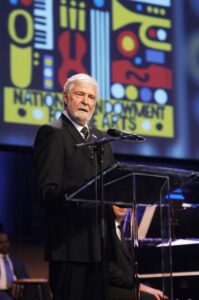Sad news:The National Endowment for the Arts has issued a statement regarding the death of….

he National Endowment for the Arts mourns the death of composer, arranger, and saxophonist Bill Holman, who was awarded the nation’s highest jazz honour, the NEA Jazz Masters Fellowship, in 2010. His distinctive and complicated arrangements have long been admired by artists and critics alike.
In a 2009 interview with the NEA following his Jazz Masters award, Holman was asked how he would describe his sound: “I’d been writing for many years before I really realised I had a sound. People would start mentioning it to me, and I’d say, “Oh, what is that?” And they’d respond, “Well, it’s contrapuntal,” or something similar. But it is more than that. Even my tunes make a sound for me. It’s similar to how your voice changes tone at the end of a sentence. Rhythm is an excellent springboard for me. If I can get momentum flowing, it usually helps me write a melodic line.
Holman began playing clarinet in junior high then tenor saxophone in high school, at which point he led his own band. After serving in the United States Navy and studying engineering, he decided in the late 1940s to pursue his dream of writing big band music and enrolled at Los Angeles’ Westlake College of Music. He also took private writing classes with Russ Garcia and saxophone lessons with Lloyd Reese.
By 1949, Holman’s career was well begun. In 1952, after writing for Charlie Barnet, he began working with Stan Kenton, with whom he would compose (and perform) for many years. During the 1950s, he was also involved in the West Coast jazz movement, performing in small bands led by Shorty Rogers and Shelly Manne and co-leading a quintet with Mel Lewis. Holman increased his writing efforts during the next decade, working with bands led by jazz legends such as Louie Bellson, Count Basie, Bob Brookmeyer, Woody Herman, Buddy Rich, Gerry Mulligan, Doc Severinsen, and others. Furthermore, he wrote for high-profile vocalists like Natalie Cole (including her Grammy Award-winning album Unforgettable), Tony Bennett, Carmen McRae, Anita O’Day, Mel Torme, and Sarah
Holman founded the Bill Holman Band in 1975, but recording proved difficult; The Bill Holman Band’s 1987 CD was his first as a leader in 27 years. Since 1980, Holman has become more active in Europe, writing, conducting, and performing longer pieces for the WDR Symphony Orchestra in Cologne, Germany, and the Metropole Orchestra in the Netherlands.
Holman has 16 Grammy nominations and three wins: Best Instrumental Arrangement of “Take the ‘A’ Train” for Doc Severinsen and the Tonight Show Orchestra (1987), Best Instrumental Composition for “A View from the Side” for the Bill Holman Band (1995), and Best Instrumental Arrangement of “Straight, No Chaser” for the Bill Holman Band (1997). He won “Best Arranger” in the JazzTimes Readers’ Poll four times and “Arranger of the Year” three times in DownBeat magazine’s Readers’ and Critics’ Polls.
In 2000, the Smithsonian Institution in Washington, DC added the Bill Holman Collection of scores and memorabilia to its permanent collection. In 2006, he was admitted into the Rutgers Jazz Hall of Fame, and in 2008, he was doubly honoured: a Golden Score Award from the American Society of Music Arrangers and Composers and a position on the American Society of Composers, Authors, and Publishers Jazz Wall of Fame.
Visit arts.gov to see a film homage to Holman and Jazz Moments, which are short audio interviews with Holman discussing his career.
